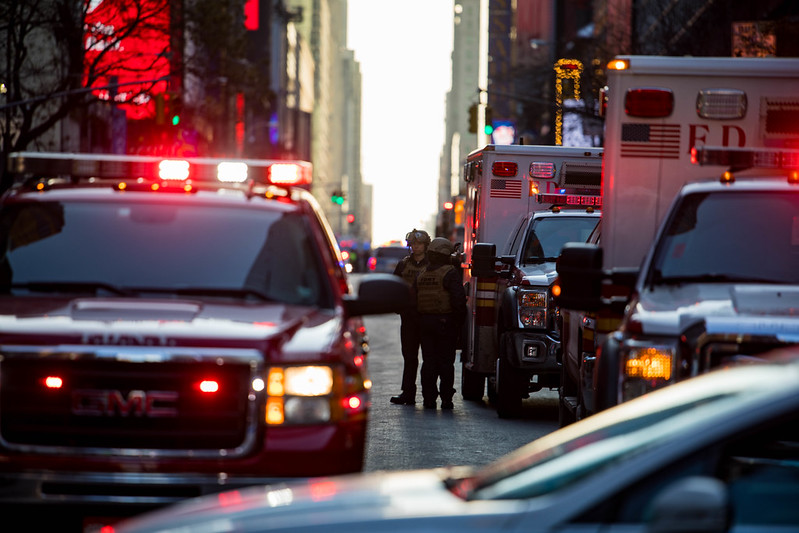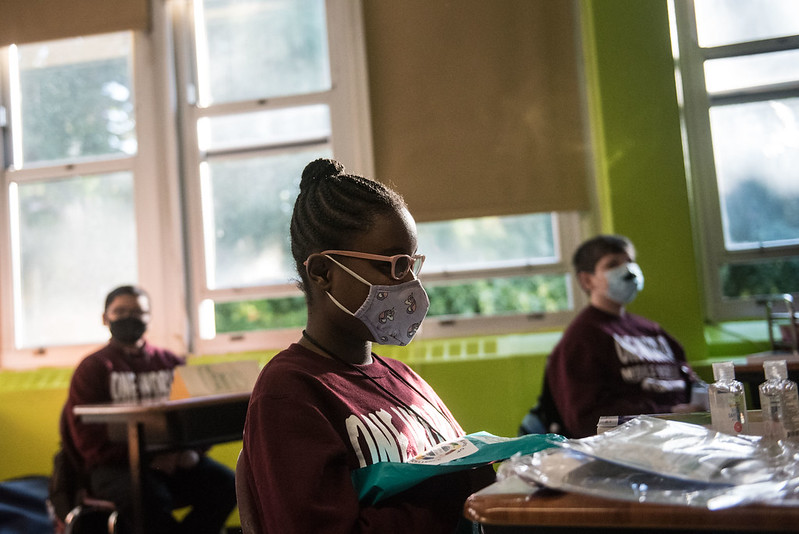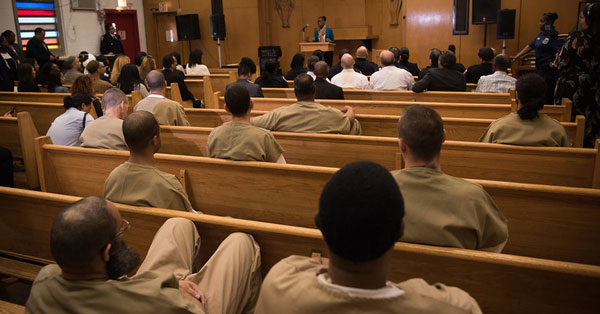De Blasio is on Right Track, But Mental Health Response Teams Need Crucial Changes to Really Work

Emergency response (photo: Benjamin Kanter/Mayoral Photo Office)
Last month, Mayor de Blasio unveiled his Executive Budget for Fiscal Year 2022, which included a $112 million line item to expand his mental health teams pilot, yet to get off the ground, citywide. Minimizing the role police officers play in responding to mental health crisis calls is a sure sign of progress, but the fact of the matter is that there is absolutely no role for law enforcement in a truly compassionate and appropriate crisis response system.
Eighteen New Yorkers experiencing mental health crises were killed in police encounters in the five-year period spanning 2015-2020, to say nothing of the many others injured and otherwise harmed.
De Blasio’s proposal stops short of the transformation that’s needed to help New Yorkers get the right support in their time of crisis. There are two key issues that must be addressed if the system is to save lives: the role of police must be eliminated, beyond the 30+% of calls the city estimates will still require police intervention; and involvement of peers—those with lived mental health crisis experience—on the teams is essential.
According to the city, the proposed mental health teams, composed of a licensed clinical social worker and emergency medical technicians from the city’s Bureau of Emergency Medical Services (EMS), are to be dispatched to “urgent, non-violent mental health needs.” Whether or not police will be dispatched is entirely up to the existing 911 call center staff, who are to use their judgement to determine if someone poses a “public safety risk.” This is a pivotal decision, and one wholly inappropriate to embed within the existing 911 processes. Leaving this decision to the discretion of the NYPD’s 911 call center leaves little hope that police will be used judiciously, and endangers those in need of care.
Meanwhile, the city’s failure to meaningfully involve trained peers is unacceptable. We can’t design or deliver new services without involving the expertise of those who are most affected by those systems. “Nothing about us, without us,” has been a clarion call of the disability rights movement for decades. Why, then, has the administration failed to incorporate the recommendations of those with lived experience as they have moved to reform our crisis response system?
Our system is in need of transformation, not merely reform, and including peers in the service delivery system is the way to ensure transformative change. Without peers as required components of the new teams, the city risks replacing one flawed system with another.
Correct Crisis Intervention Today in NYC (CCIT-NYC) has developed a proposal, first shared with the de Blasio administration last spring, that properly addresses these issues. Our mental health teams consist of one trained peer and one independent emergency medical technician (EMT). Given the embedded nature of the city’s EMS within the current, flawed system, as well as EMS’ own admission that they do not wish to take on this task, we believe independent EMTs are a better choice. And, we have built our proposal on successful models found elsewhere in the country, like CAHOOTS in Eugene, Oregon, which has a nearly 40-year track record of responding to mental health crises without a single injury to those experiencing a crisis or to its staff.
Most importantly, our proposal was developed by the very people who are likely to be on the receiving end of such a system. Indeed, many of us have had experience with police officers when experiencing a crisis.
De Blasio’s initiative is a welcome first step, but the city must take another look and get this right. Failure to do so puts New Yorkers in crisis at risk of serious harm from police violence. System transformation is possible. It is long overdue. And it must happen now.
***
Cal Hedigan, CEO of Community Access, and Carla Rabinowitz, Advocacy Coordinator at Community Access, are members of Correct Crisis Intervention Today - NYC (CCIT-NYC). On Twitter @ca_nyc and @ccitnyc.
***
Have an op-ed idea or submission for Gotham Gazette? Email This email address is being protected from spambots. You need JavaScript enabled to view it.
Dream Big Dreams: How Federal and State Covid Relief Can Be Used to Revitalize New York City’s Public Schools

Students at school (photo: Michael Appleton/Mayoral Photography Office)
In 1951, Langston Hughes famously asked, “what happens to a dream deferred? Does it dry up like a raisin in the sun, or fester like a sore and then run? Does it stink like rotten meat? Or crust and sugar over—like a syrupy sweet? Maybe it just sags like a heavy load. Or does it explode?”
For years, the dreams of children in our community have been deferred. They have been deferred through an army of overcrowded classes, an assembly line of underfunded schools, and a sea of broken promises. The result: far too many low GPAs, poor standardized test performances, and a high rate of placement in special education programs.
However, with the passage of the federal American Rescue Plan Act, plus an additional $1.3 billion from the State on top of expected funding, New York City is looking at an additional $8.2 billion in public school support. It’s a once in a generation opportunity to reimagine schooling in our city. Here’s how we can get it done:
1. Create an Individualized Success Plan for Every Student
Every child needs to know that we are invested in his or her future. This starts by taking a more personalized approach to the learning process.
Each child should receive an individualized success plan that accounts for academic performance, home environment, and any non-academic variables that impact his or her ability to learn. There should also be benchmarks at every stage of the child’s learning cycle, and students and families should be encouraged to provide feedback during the plan-making process. By having an individualized success plan, we can make sure our kids aren’t falling behind.
2. Increase Academic Enrichment Opportunities and Aggressively Tackle Learning Loss
There is a direct connection between the amount of time students are engaged in learning and academic achievement. The more time we can devote to teaching our students, the better they will do academically. To put it bluntly, we need longer school days and more after-school tutoring. We must expand summer school and explore Saturday school options.
I’ve seen firsthand what additional academic enrichment can do for student achievement. Four years ago, I started a free tutoring and mentoring program called DREAMChasers. In a short amount of time, we’ve been able to get our students into top schools such as Brooklyn Technical High School, the Bronx High School of Science, and Stuyvesant High School.
The reason our program works is because our students have more time to focus on their studies. No matter where our kids matriculate, they enter high school with over 300 additional hours of tutoring in math, English, and reading comprehension.
The more opportunities we give our kids to succeed, the more likely they are to reach their potential.
3. Experiment with Offering Mastery Level Learning Classes in Public Schools
At the Khan Academy, they employ a teaching philosophy called “Mastery Learning,” where they focus on developing a deep understanding of concepts and mastering skills before moving to the next subject. The Khan Academy is a world-renowned educational organization that provides free, world-class education to anyone, anywhere online. It empowers students who can handle more academic work to move faster through subject areas, while allowing students who need additional assistance ‘mastering’ core concepts, additional time before moving on to more advanced lessons.
We need to transition to a mastery learning system here in New York. Too often, students advance without developing a proficiency in the basics. They’ve experimented with incorporating mastery learning into California public schools and are already seeing promising results. Switching to a mastery learning model could be the key to ensuring that our students are receiving a quality education.
4. Transforming Public Schools into Community Schools
A community school is a school that offers wrap-around services that address the well-being of our children. They provide students with access to health care, mentoring, and social services, making it easier to thrive academically. Community schools have been effective in increasing graduation rates, curbing absenteeism, and increasing academic achievement for students coming from low-income, English language learning, disabled, and temporary-housing home environments.
If we can transform more of our local schools into community schools, we can make sure students dealing with physical, emotional, or social challenges have the help they need so they can focus on their studies.
And, in the early evenings, community schools could be used as sites for young moms and dads who want to finish high school – offering free child care while their parents learn.
It’s a holistic approach to teaching that makes it easier for our kids to learn.
5. Expand College or Career Readiness Fellowship Programs for Out-of-School and Out-of-Work Students
We need to do a better job preparing our young people for life after high school. As of December 2017, the three-year graduation rate at CUNY community colleges was just 22%. That is an incredulously low number! Furthermore, nearly 25% of all young people ages 18 to 24 are unemployed and not enrolled in school. The answer is more college or career readiness opportunities so that disconnected youth can thrive in college and build a career.
For high school graduates interested in enrolling in college, they would attend classes that would help them improve their math, writing, and reading comprehension skills, as well as prepare them for life as a college student. If they’re more prepared for college, they are more likely to graduate.
For those interested in a career, course work would be focused on preparing them for jobs in high-need and high-growth sectors. Even now, there are job opportunities in areas such as information technology, financial services, climate-resiliency, and health care. With the proper training, we can put our young folks on track to securing jobs that pay a competitive wage and achieve the financial stability needed to raise a family. It could make all the difference for youth in danger of becoming disconnected.
In 2019, the city created CareerReadyNYC, to help disconnected youth prepare for the workforce. However, because of the pandemic, things have changed. Here in Southeast Queens, we’ve seen a surge of out-of-school and out-of-work students. By increasing our investment in career readiness programming, we can get some of our most vulnerable young folks back on track.
With the state and federal funds we are about to receive, we have a bona-fide opportunity to reset our public school system and offer a quality education to our students.
Let’s make the commitment to individualize the learning process and expand enrichment opportunities.
Let’s implement a mastery learning system and build more community schools.
Let’s expand college and career readiness programs that give our kids the support they need after graduating high school.
Dreams only defer if we let them. It’s time to take back our children’s future.
***
Jason Myles Clark, Esq. is the founder of the free tutoring and mentoring program DREAMChasers and a Democratic Candidate for City Council in Queens’ District 27. On Twitter @jasonmylesclark.
***
Have an op-ed idea or submission for Gotham Gazette? Email This email address is being protected from spambots. You need JavaScript enabled to view it.
A Simple But Essential Step to Help Limit Recidivism

Rikers Island detainees (photo: Michael Appleton/Mayoral Photography Office)
In New York, our rates of recidivism are unacceptably high. An estimated 45% of all parolees in New York City experience a re-arrest within two years.
Eliminating barriers to reintegration into society is a proven, fact-based way that we can reduce recidivism, and that starts by treating formerly incarcerated people as regular people.
In New York, we place a needless hurdle in the way of enabling a formerly incarcerated person from succeeding. Currently, when a person is released from prison, they are given a temporary ID card from the Department of Corrections. In essence, they carry around a card labeling them as a former convict.
This makes it much, much harder for someone returning home to proceed with the day-to-day things they need to succeed in re-building their life. Imagine trying to do something as routine as applying for an apartment and having the broker look at you with fear after seeing that you were incarcerated, or going to a job interview and having the employer immediately question whether you can be trusted. This is what New Yorkers who have paid their debt to society face right now, and it’s not fair.
Reintegrating into society after incarceration is a daunting task. Half the people who get out go straight into a homeless shelter. They need to find a place to live. They need to find a job. Giving them a card that labels them as a former convict only makes this even harder. Instead of providing a released person with the same kind of identification we all have, they are given something that simply makes it more difficult for them to succeed, which is the goal not just for the person returning to society, but for all of us. The stigma associated with these IDs is both unnecessary and extremely harmful.
Our system of incarceration has lost its focus -- we should be doing everything in our power to reduce incarceration and recidivism, and lowering these rates should be our measure of success.
We cannot continue to incarcerate Black and brown New Yorkers at such alarming and disproportionate rates, and we need to step back and refocus our efforts on both keeping people out of prison and giving them the tools to succeed and avoid recidivism once they are released. While reforming our policing is part of the equation, it’s on our lawmakers to take action now to reverse this damage.
The truth is this: there’s no public safety reason that anyone can articulate as to why these stigmatized Corrections-issued IDs are necessary in place of a regular, non-driver ID. Why are we complicating the process when what we really need is assistance for people focused on reintegration back into society, finding a job, and spending time with loved ones?
This issue may seem like a small one, but it will make a world of difference for someone who is trying to rejoin society and obtain a job. The number one thing we can do in our state to reduce recidivism is eliminate the barriers to reintegration.
Our legislation, S1149/A4905, will require the state to provide returnees with a non-driver identification card — which is available to any New Yorker — to each incarcerated individual upon their release from custody. These IDs will help formerly-incarcerated people obtain jobs and live normal lives after their release, which will in turn help to lower our rates of recidivism by supporting reintegration. The state already has the information necessary to issue every person released from prison with a non-driver ID, so implementing this should be easy.
Let’s cut through the bureaucracy and simplify the process.
There’s ample precedent that proves such a program could work. In New York City, there is an already established partnership with the Department of Motor Vehicles that assists parolees in obtaining a non-driver ID. It should be easy for us to use this already existing partnership to provide IDs that don’t carry a stigma to those who have been released from prison.
This issue shouldn’t be a controversial one. A state-issued ID could be the difference for someone struggling to readjust to life on the outside, and it could be the key to reducing recidivism in our state.
This is common sense legislation, and our colleagues in the New York State Legislature should join us and pass S1149/A4905 now.
***
Senator Brian Benjamin and Assemblymember David Weprin are members of the New York State Legislature, and are both candidates for New York City Comptroller. On Twitter @NYSenBenjamin & @DavidWeprin.
***
Have an op-ed idea or submission for Gotham Gazette? Email This email address is being protected from spambots. You need JavaScript enabled to view it.




